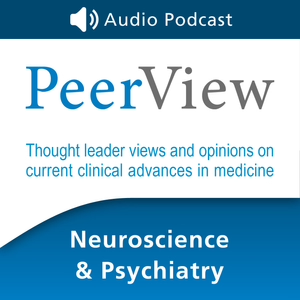
PeerView Neuroscience & Psychiatry CME/CNE/CPE Audio Podcast
PVI, PeerView Institute for Medical Education
All episodes
Best episodes
Top 10 PeerView Neuroscience & Psychiatry CME/CNE/CPE Audio Podcast Episodes
Goodpods has curated a list of the 10 best PeerView Neuroscience & Psychiatry CME/CNE/CPE Audio Podcast episodes, ranked by the number of listens and likes each episode have garnered from our listeners. If you are listening to PeerView Neuroscience & Psychiatry CME/CNE/CPE Audio Podcast for the first time, there's no better place to start than with one of these standout episodes. If you are a fan of the show, vote for your favorite PeerView Neuroscience & Psychiatry CME/CNE/CPE Audio Podcast episode by adding your comments to the episode page.

J. Sloan Manning, MD - Overcoming Disparities in the Accurate Diagnosis and Optimal Management of MDD in Rural America
PeerView Neuroscience & Psychiatry CME/CNE/CPE Audio Podcast
08/27/18 • 38 min

Michael Polydefkis, MD - Clinical Pearls for the Accurate Diagnosis and Optimal Treatment of Hereditary ATTR Amyloidosis
PeerView Neuroscience & Psychiatry CME/CNE/CPE Audio Podcast
07/31/19 • 21 min

Karl E. Anderson, MD - Acute Hepatic Porphyria: Disease Diagnosis and Revelations Regarding the Role of siRNA Therapy
PeerView Neuroscience & Psychiatry CME/CNE/CPE Audio Podcast
06/02/21 • 31 min

Gregory W. Albers, MD / S. Claiborne “Clay” Johnston, MD, PhD - Mastering the Use of Dual Antiplatelet Therapy for Preventing Recurrent Stroke: How Well Do Your Current Strategies Match With the Experts?
PeerView Neuroscience & Psychiatry CME/CNE/CPE Audio Podcast
04/15/22 • 86 min

Bruce Cree, MD, PhD, MAS - Re-Examining S1PR Modulation From All Angles in Relapsing Multiple Sclerosis: Impact on Physical and Cognitive Outcomes, and Practical Considerations of Long-Term Therapy
PeerView Neuroscience & Psychiatry CME/CNE/CPE Audio Podcast
08/05/22 • 60 min

David G. Warnock, MD - The Future Looks Bright for People With Fabry Disease: Improving Diagnosis and Expanding Treatment Options
PeerView Neuroscience & Psychiatry CME/CNE/CPE Audio Podcast
12/19/22 • 32 min

Stephen Krieger, MD, FAAN / Clyde E. Markowitz, MD - Navigating the Evolving Management Paradigm Across Multiple Sclerosis Phenotypes in the Age of Potential Prognostic and Predictive Biomarkers
PeerView Neuroscience & Psychiatry CME/CNE/CPE Audio Podcast
05/13/20 • 51 min

Diana Castro, MD - Altering the Natural History of Spinal Muscular Atrophy: A Compelling Story Highlighting the Critical Role of Presymptomatic Treatment
PeerView Neuroscience & Psychiatry CME/CNE/CPE Audio Podcast
01/24/20 • 25 min

Steven Brem, MD - Brainstorming Personalized Care Strategies in Glioblastoma: Rethinking and Refining Therapeutic Algorithms With Tumor Treating Fields and Novel Systemic Approaches
PeerView Neuroscience & Psychiatry CME/CNE/CPE Audio Podcast
01/15/20 • 54 min

Barry Singer, MD - Taking Stock of Late-Breaking Data on Disease-Modifying Therapies for Multiple Sclerosis: What Are the Key Learnings From Berlin?
PeerView Neuroscience & Psychiatry CME/CNE/CPE Audio Podcast
01/23/19 • 43 min
Show more best episodes

Show more best episodes
FAQ
How many episodes does PeerView Neuroscience & Psychiatry CME/CNE/CPE Audio Podcast have?
PeerView Neuroscience & Psychiatry CME/CNE/CPE Audio Podcast currently has 154 episodes available.
What topics does PeerView Neuroscience & Psychiatry CME/CNE/CPE Audio Podcast cover?
The podcast is about Health & Fitness, Neuroscience, Cme, Medicine, Neurology, Podcasts, Science, Medical Education and Psychiatry.
What is the most popular episode on PeerView Neuroscience & Psychiatry CME/CNE/CPE Audio Podcast?
The episode title '"Brenda L. Banwell, MD, FAAP, FRCPC, FAAN - Addressing Barriers to the Ready Recognition and Timely Treatment of Pediatric Multiple Sclerosis"' is the most popular.
What is the average episode length on PeerView Neuroscience & Psychiatry CME/CNE/CPE Audio Podcast?
The average episode length on PeerView Neuroscience & Psychiatry CME/CNE/CPE Audio Podcast is 45 minutes.
How often are episodes of PeerView Neuroscience & Psychiatry CME/CNE/CPE Audio Podcast released?
Episodes of PeerView Neuroscience & Psychiatry CME/CNE/CPE Audio Podcast are typically released every 9 days.
When was the first episode of PeerView Neuroscience & Psychiatry CME/CNE/CPE Audio Podcast?
The first episode of PeerView Neuroscience & Psychiatry CME/CNE/CPE Audio Podcast was released on Aug 27, 2018.
Show more FAQ

Show more FAQ